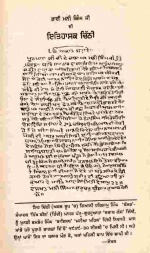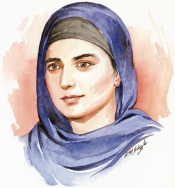Template:RecentArticles: Difference between revisions
Hari singh (talk | contribs) No edit summary |
Hari singh (talk | contribs) mNo edit summary |
||
| Line 28: | Line 28: | ||
<big>[[Establishment of Kartarpur]] </big> - Having completed the 4 udasisa (journeys), after a short stay at Lahore, Guru Nanak began his travels once more. This time he directed his steps towards his native village, Talwandi. As usual, he travelled by short stages.... | <big>[[Establishment of Kartarpur]] </big> - Having completed the 4 udasisa (journeys), after a short stay at Lahore, Guru Nanak began his travels once more. This time he directed his steps towards his native village, Talwandi. As usual, he travelled by short stages.... | ||
[[Image:Sikh | [[Image:Sikh lady.jpg|thumb|175px|left|Water painting of a Sikh Women in Dastar (Turban)]] | ||
<big>'''[[Sikh Women|WOMEN IN SIKHISM:]]'''</big> In Sikhism, the Sikh women are regarded as equal with men and have all the rights and privileges enjoyed by men. The woman is considered to have the same soul as man and has equal right to grow spiritually. The Sikh woman is allowed to lead religious congregations, to take part in Akhand Path (the continuous recitation of the Holy Scriptures), to perform Kirtan, to work as Granthi (priest) or a preacher and to participate freely in all religious, cultural, social, political and secular activities...... | <big>'''[[Sikh Women|WOMEN IN SIKHISM:]]'''</big> In Sikhism, the Sikh women are regarded as equal with men and have all the rights and privileges enjoyed by men. The woman is considered to have the same soul as man and has equal right to grow spiritually. The Sikh woman is allowed to lead religious congregations, to take part in Akhand Path (the continuous recitation of the Holy Scriptures), to perform Kirtan, to work as Granthi (priest) or a preacher and to participate freely in all religious, cultural, social, political and secular activities...... | ||
Revision as of 20:22, 2 June 2006
Below are listed some of the most recent articles added to SikhiWiki. Click on the title of the article to read the full text.
Kirpan: In 1699, Guru Gobind Singh told his Sikhs at the Baisakhi Amrit Sanchar to constantly and regularly wear a Kirpan at all times. This was an article of defence which together with the other 4 Kakars formed the external visible symbols to outwardly display ones commitment to the Hukam of the tenth master.
This injunction was primarily in order to protect the weak from tyranny and slavery, to maintain a state of harmony and security, to allow for the free development of trade, craftsmanship, arts & literature and to safeguard and protect the universal right of all beings to live their lives in a peaceful, stable and sheltered environment. .....
Dasam Granth: The Dasam Granth contains 1428 pages and is the collection of the writings of the 10th Patshah, Sri Guru Gobind Singh Ji. It contains his Jaap Sahib, the Akal Ustat or praise of the Creator, the Vachitar Natak or Wonderful Drama, in which the Guru gives an account of his parentage, his divine mission, and the battles in which he had been engaged.
Then come three abridged translations of the Devi Mahatamya, an episode in the Markandeya Puran, in praise of Durga the Goddess of war (Chandi Chritras: Chandi Chritra I, Chandi Chritra II, Chandi Ki Var)......
Watering the Crops Guru Nanak Dev ji while on his eastward journey reached Haridwar. It is on the banks of the river Ganges and is one of the major centers for Hindu pilgrimage. The people, gathered there in large numbers, were bathing in the holy river. Guru Nanak Dev observed many people throwing water towards the sun in the east. The Guru had already heard about this meaningless ritual. He, therefore, thought it the right place and the proper time to give correct guidance that those kinds of mindless hollow rituals have no value....
Miri Piri The term “miri, piri” in Sikh tradition reflects the temporal (worldly) and spiritual components of life. The term represents for the Sikhs a basic principle which has influenced their political thought and has governed their social structure, political behaviour, organisation, leadership and politics...
Bhai Makhan Shah used to bring valuable merchandise by sea from far away lands and sell it wholesale in parts of Gujarat and Punjab in India. Once, while he was returning home with his ship carrying valuable goods over the vast seas, his ship got caught up in a furious storm....
Videos on Sikhism This page links to various Videos on Sikh and Sikhism that can be found on the Internet.
Establishment of Kartarpur - Having completed the 4 udasisa (journeys), after a short stay at Lahore, Guru Nanak began his travels once more. This time he directed his steps towards his native village, Talwandi. As usual, he travelled by short stages....
WOMEN IN SIKHISM: In Sikhism, the Sikh women are regarded as equal with men and have all the rights and privileges enjoyed by men. The woman is considered to have the same soul as man and has equal right to grow spiritually. The Sikh woman is allowed to lead religious congregations, to take part in Akhand Path (the continuous recitation of the Holy Scriptures), to perform Kirtan, to work as Granthi (priest) or a preacher and to participate freely in all religious, cultural, social, political and secular activities......
Khalsa Akal Purakh ki Fauj The Khalsa is given a unique and unprecedented position by the tenth Sikh Guru, Guru Gobind Singh. The Guru defines the Khalsa as the Army of God – Not an army of the Sikhs or of the Khalsa but the Army of the Almighty...



